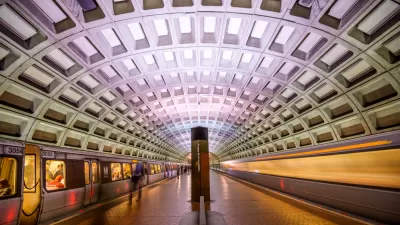In the premier episode of NPR's special series, "U.S. Commutes: The Way We Get To Work", host David Greene explores the background of the D.C. suburb of Arlington, Va., and how a planning decision in the 1960s was crucial to its vibrancy today.
Arlington County was transformed from a sleepy, car-dependent suburb of the District of Columbia to a vibrant community because of a risky planning decision regarding placement of the Ballston, Washington Metro subway station made half a century ago. "Instead of having a line bypass these nearby Virginia suburbs aboveground, next to a highway, planners decided to run it underground and redevelop the neighborhoods above", writes NPR's Morning Programming Host/Correspondent David Greene. [Listen here].
"I think we were bold at the time, and it has paid off. I can't imagine what this area would be like without it," says Jay Ricks, a former board member in Arlington County.
Arlington is one of those few communities that has seen an increase in population and decrease in traffic, due not only to its relationship with the Metro, but the manner in which it has developed, receiving the 2002 Environmental Protection Agency smart growth award for it. Now it risks being a victim of its own success, according to Arlington resident and EPA employee Lynn Richards, who fears skyrocketing housing prices "could eventually undermine one of the main purposes there — to change a community without increasing traffic."
Robert Brosnan, the county planning chief, expresses pride in the accomplishments of the county, one that draws visitors from abroad (the tape features urban planners from China) to study. When asked by Greene what can be improved, he points to architecture.
"Look at this building. We were ecstatic about that at the time, but you look at it now, you say, 'Oh boy, this is a new city.' It's been developed over the past 35 years. So I think it's a matter of refinement and maturing."
One of the delightful parts of the broadcast is Greene accompanying Arlington resident Becca Bullard on her commute to downtown Washington that involves a smart phone (to check bus arrival time), and "cutting through the bushes" during the rush to a bus stop for her trip to the Metro.
Correspondent's note: According to Wikipedia, Arlington County, "(w)ith a land area of 26 square miles (67 km2), is the geographically smallest self-governing county in the United States, and due to state law regarding population density, has no other incorporated towns within its borders."
FULL STORY: How One D.C. Suburb Set A Gold Standard For Commuting

Planetizen Federal Action Tracker
A weekly monitor of how Trump’s orders and actions are impacting planners and planning in America.

Map: Where Senate Republicans Want to Sell Your Public Lands
For public land advocates, the Senate Republicans’ proposal to sell millions of acres of public land in the West is “the biggest fight of their careers.”

Restaurant Patios Were a Pandemic Win — Why Were They so Hard to Keep?
Social distancing requirements and changes in travel patterns prompted cities to pilot new uses for street and sidewalk space. Then it got complicated.

Platform Pilsner: Vancouver Transit Agency Releases... a Beer?
TransLink will receive a portion of every sale of the four-pack.

Toronto Weighs Cheaper Transit, Parking Hikes for Major Events
Special event rates would take effect during large festivals, sports games and concerts to ‘discourage driving, manage congestion and free up space for transit.”

Berlin to Consider Car-Free Zone Larger Than Manhattan
The area bound by the 22-mile Ringbahn would still allow 12 uses of a private automobile per year per person, and several other exemptions.
Urban Design for Planners 1: Software Tools
This six-course series explores essential urban design concepts using open source software and equips planners with the tools they need to participate fully in the urban design process.
Planning for Universal Design
Learn the tools for implementing Universal Design in planning regulations.
Heyer Gruel & Associates PA
JM Goldson LLC
Custer County Colorado
City of Camden Redevelopment Agency
City of Astoria
Transportation Research & Education Center (TREC) at Portland State University
Camden Redevelopment Agency
City of Claremont
Municipality of Princeton (NJ)





























